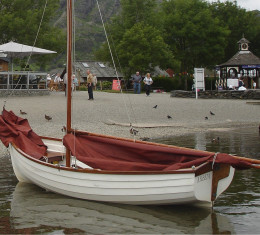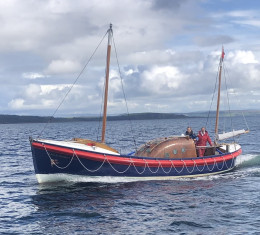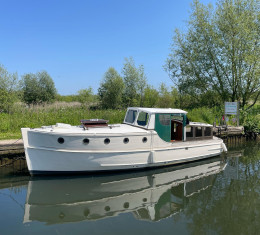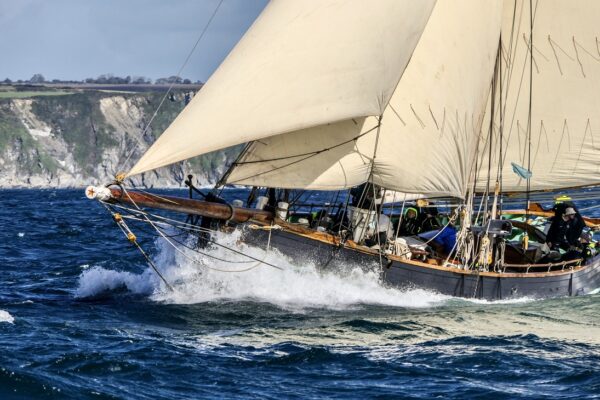Sailing yachts
Full specification
Wooden ships comments on this International One Design (IOD)
Designed and built by Bjarne Aas in Norway, 1958. Hull No. 440
The International One-Design Class was conceived to build, maintain and race a fleet of “One-Design yachts, distinctive in appearance and performance, using one-design racing in order to develop the competitive capacities of both helmsmen and crews under the fairest and most equal conditions.”
The design of the International One-Design was inspired by a Six Metre created by the famous Norwegian architect and builder Bjarne Aas, in 1935. Cornelius Shields, Sr., impressed by her beauty and handling qualities when he saw one sailing in Bermuda, initiated action for an entire Class similar in design and appearance to the 6m but with a loftier rig, a short shelter and a storage cabin. Aas submitted plans and specifications in 1936 and a syndicate was formed. In late 1936, twenty-five International One-Design yachts were delivered from Norway and commenced racing on Long Island Sound. Since that time, other fleets have formed in Norway, the UK, Bermuda, Canada and the United States.
With 12 fleets in 5 countries and over 150 yachts actively racing, the International One Design was the first class to be recognized by ISAF as a “Classic” One Design Class.
Prior to the Second World War The Royal Corinthian Yacht Club in Burnham on Crouch was the premier location for one design racing in England. In particular during the thirties it was the centre of 6 metre racing, attracting helmsmen from all parts of the world. As 6 metre racing became more intense at national and international level, so the costs escalated.
‘Tiny Mitchell’, then Commodore of the Corinthian, a post he held with distinction from 1931 to 1952, was well aware of the limitations that participating imposed and he did much to encourage the less costly racing classes such as the Dragon. Through his close association with the 6 metre class he was well informed on the origins of the IOD and recognised its undoubted potential. In 1938 he purchased Bombero and this was sailed by his son E.B.N. (Budd) Mitchell, later to own Tadpole. In order to encourage the class Bombero was sold to John Mould in 1939 and the Mitchell family took delivery of Nauta. Margaret, built in 1938, was brought to Burnham in 1939 and joined the fourth member of the class Flirt, owned by C Peto Bennet. These four boats formed the nucleus of the Burnham fleet and raced regularly as a class in 1939.
The Second World War and its aftermath were nearly fatal for the IOD class. During the war, legend says that Aas buried the construction jigs to protect them during the Nazi occupation. Everywhere the yachts were laid up and the materials used in the ‘golden era’ of wood, iron and mild steel were savaged by neglect.
Post War, the ‘Yachting Monthly’ (March 1949) carried an article on the International One Design and suggested that C Peto Bennet was planning to build IODS in the UK, by arrangement with Bjarne Aas. In fact this did not happen. The article goes on to praise the sea worthiness of the boat in the hardest of weathers as proved at the Hanko Regatta of 1947.
This and the opening of The Royal Corinthian Yacht Club at Cowes encouraged the Burnham boats to move south leading to a full IOD class racing on the Solent. The class now started to generate more interest and throughout the ‘50’s new boats were added to the fleet on a regular basis.
By 1973 most of the fleet had moved to the Royal Forth Yacht Club (RFYC) totalling 13 boats, 11 purchased from the Solent and 2, Arrow and Wahoo, from the Channel Islands. There followed a period of active and very competitive racing, with the fleet taking part in the IOD Worlds for the first time in 1974 at Larchmont, USA and hosting the Worlds on the Forth in 1975, 1979, 1984, 1990 and 1998.
From 1984, boats started to move west to the Clyde where there was a nucleus of three boats, Mirenda, Wildgoose and Starlight. The Worlds were held for the first time at the Royal Northern & Clyde Yacht Club in 1990 with the reduced Forth fleet transported to the Clyde and 1995 saw the complete transition of the IOD fleet to the Royal Northern & Clyde Yacht Club (RNCYC) at Rhu.
International One Designs have added colour and competitiveness to yacht racing wherever they have been based in the UK. In recent years the Clyde fleet dispersed and a small fleet collected in St Mawes, Cornwall though now also slowly dispersing.
While these boats have been raced competitively for many years, they are also wonderful day sailers even in unsheltered waters and it is this feature of the design which makes them nowadays so attractive to many owners who prefer exciting pottering to competitive hard racing.
Planked in mahogany on laminated mahogany frames at approx 3’ centres with 2 x steamed oak intermediates. The planking is laid tight-seamed and screw fastened to both the heavier laminated frames and the steam bent timbers.
The planking is varnished on the inside and painted externally.
Straight-cut mahogany web floors on every second frame running forward of the mast up the stem ensure the strength of the long overhang in pounding conditions. Several similar floors up into the counter secure that area. Midships, several heavy section cross cut oak floors also carry the ballast keel bolts and give huge strength to the tight deep bilge and support to the ballast keel.
Most boats still have a pair of eye bolts in the midships bilge to take lifting straps which allowed them to be craned.
K18 was recently fitted with a new teak deck on a marine ply sub deck, beautifully laid to the varnished mahogany cover-boards in narrow and tapering scrubbed teak planks joggled in to a varnished mahogany cover-board.
In proper IOD design she has a teak grab rail either side of the fore deck almost back as far as the mast providing a toe-hold for the fore deck crew.
A very attractive feature of the IOD is the small cabin roof built with varnished mahogany coamings and a scrubbed teak deck also joggled to a varnished mahogany cover-board.
Two fixed lights each side in chromed bezels and one recessed fixed light in the fwd face of the coaming.
The cock-pit is deep with adequate space for the full race crew of 4. The fifth member is usually allocated his seat at the foot of the mast, port or stbd depending on which tack was being sailed.
Because K18 has been fitted with an engine she now has a full width bridge deck with a centre opening flap to sight the engine.
A sliding hatch and wash-boards close the cabin entrance.
Slatted side seats run aft from the bridge deck leaving the under side deck space open each side.
Slatted scrubbed hardwood cock-pit sole in sections which can be lifted to access the deep bilge well below allowing constant sight of any water in the bilge when racing.
Deep varnished mahogany coamings round the cock-pit give excellent protection and the crew sit in this boat, not on it and even in a strong breeze hiking out is generally not required or desireable.
The cock-pit is open right up into the counter giving total ventilation to this potentially vulnerable area.
The raked rudder stock emerges from it’s stock-tube part way up the counter below deck with a varnished ash tiller which can sweep the cock-pit side to side out under the side decks.
The fore deck carries a single centre-line chromed cleat to take the forward mooring line running over a single stemhead chromed roller fitting. A single chromed cleat on the aft deck takes the after line with a single chromed fairlead alongside the chromed ensign staff socket.
This is an exquisite and totally uncluttered, clear deck emphasising this yacht’s perfect clean lines.
Rig.
Fractional bermudian sloop rig on a 2002 aluminium mast stepped through the main deck forward of the coach-roof onto the keel.
Pair of stainless steel tie rods each side from mast step to chain plates at the beam-shelf.
Single spreaders with jumpers above.
2002 stainless steel rigging with single lowers and cap shrouds each side to a stainless steel bar carried on a pair of stainless steel chain plates reaching internally down the topsides thus very adequately spreading the rig loads.
Single back-stay to the aft deck through to a turning pulley and set up to a 4-part tackle under the aft deck.
Fore stay incorporated into the head-sail roller reefing gear set back from the stemhead with under-deck roller drum. Rolling lanyard taken aft through the cabin bulkhead to the cock-pit so the headsail can be reefed or furled from the cock-pit.
Halyards, spinnaker lifts etc in mast with a winch at the foot of the mast in the cabin and a pair of jamming cleats.
Alloy boom sheeted to the aft deck on tufnol blocks with single tail lead into the cock-pit through the after coaming, stbd corner to a cleat on the inside of the stbd coaming.
Alloy slab reef boom with two internal reef pennants. Ram’s horns at the goose neck.
Headsail sheets through short athwartships tracks carrying lead blocks allows the clew to be moved in and out.
Boom topping lift.
Kicking strap on tackle.
A versatile rig which can be totally controlled and tuned from the cock-pit.
Winches.
Pair of Anderson self tailing sheet winches on the cock-pit coamings
Lewmar 8 top action winch at the mast step.
Sails.
2 x mainsails
Jib on under-deck roller furling gear.
Spinnaker.
Alloy spinnaker pole.
Mainsail cover
Machinery
Yanmar 10hp single cylinder diesel engine on the centre-line with centre-line shaft to off-set folding prop.
Single lever engine controls stnd side of the cock-pit.
12v battery in the bridge deck locker to port of the engine.
Equipment
Anchor
40’ chain
Life buoy
Fenders
Mooring warps
Cock-pit cover.
Depth/speed indicator
Disclaimer:
These particulars have been prepared in good faith from information provided by the Vendors and are intended as a guide, Wooden Ships cannot guarantee or warrant the accuracy of this information nor warrant the condition of the vessel. The Purchaser should instruct his agent or surveyor to validate all details as necessary and satisfy himself with the condition of the vessel and its equipment.
Wooden Ships classic yachts brokers have an extensive database of boats for sale. With a wide range of sailboats, classic yachts, motor yachts and small classic boats, Wooden Ships has one of the largest selections of traditional wooden boats and yachts for sale in the UK.
Disclaimer:
These particulars have been prepared in good faith from information provided by the Vendors and are intended as a guide, Wooden Ships cannot guarantee or warrant the accuracy of this information nor warrant the condition of the vessel. The Purchaser should instruct his agent or surveyor to validate all details as necessary and satisfy himself with the condition of the vessel and its equipment.




























